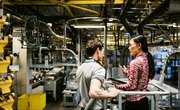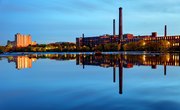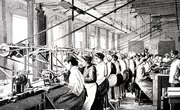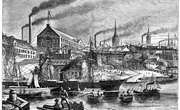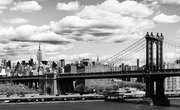The Industrial Revolution took place during the 18th and 19th centuries when major technological breakthroughs changed the ways in which manufacturing, agriculture and trade were conducted. Inventions like the cotton gin, steam engine and sewing machine transformed entire economies and brought deep and lasting change to all classes of people.
The Rich Got Richer
With the advent of new technologies, mass-produced goods could be created and sold more cheaply and quickly than ever before, inciting a surge of production and consumption. With the explosion of manufacturing and trade, the rich who owned businesses got even richer. Middle-class factory owners who were very successful were able to move into the upper class. The tremendous new wealth created by industrialization allowed the upper class to build huge mansions, collect fine art and erect museums and libraries. The privileged social group had always enjoyed prosperity, but now they achieved a new realm of luxury and extravagance.
The Middle Class Grows
As a group, the middle class saw enormous benefits from the industrial revolution. The growth of new businesses and factories created thousands of new jobs. The middle class itself grew in size as occupations like merchants, shopkeepers and accountants allowed the working class to lift themselves into a higher social strata. As these workers earned more, they were able to take advantage of the newly affordable amenities like furniture and fine clothing, giving themselves a comfortable life. They were also able to educate their children, so that their social standing would be maintained or even rise with the next generation.
The Poor Remain Poor
For the poor and working-class people, their lives changed, but didn’t necessarily improve. For centuries before the industrial revolution, the lower classes had earned their living through jobs in agriculture; now they worked in factories. Because factory work was usually easier than working in the fields, women and children joined the workforce in huge numbers. Wages, though, were very low, and even with an entire family working, it was hard to earn a decent living. Furthermore, the working conditions were often filthy, dangerous, or both. At the very least, the work was repetitive and menial in nature. As families needing jobs sought work in factories, they swarmed into cities, and the cities became overcrowded and rife with disease. Children who worked all day did not go to school, and so did not receive an education or advance themselves.
The Rising Tide Did Not Lift All Boats
The industrial revolution had a lasting impact on all people, but not all classes benefited equally. Those who could take advantage of the better jobs or professions, or those who were lucky enough to be business owners, were able to enjoy comfort, privilege and leisure in many ways. Those who were uneducated and limited to unskilled labor often remained stuck at the bottom of the economic pile. Their working and living conditions lacked any comfort or safety, and their lives were often miserable, or at best, simply dreary and dead-end.
Related Articles
References
Writer Bio
Pam Lobley was a regular columnist on the Op Ed page of "The Bergen Record" for three years; in addition, her columns have appeared in many newspapers, such as "The New York Times" "The Philadelphia Inquirer," "The Chicago Tribune" and several others. As a playwright, her work has been produced regionally and in New York City.




